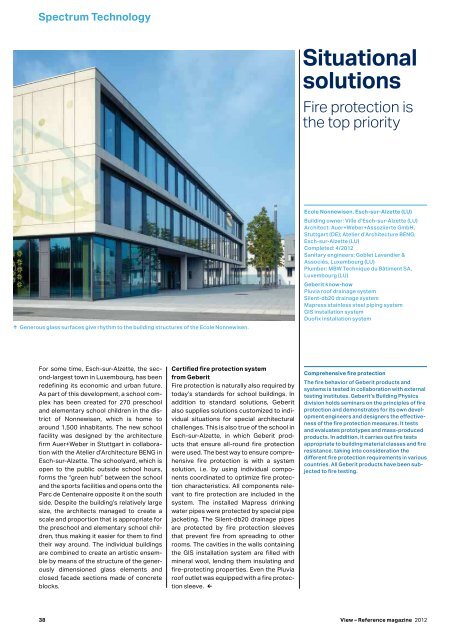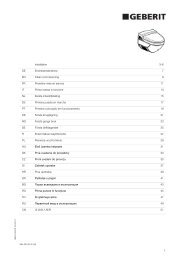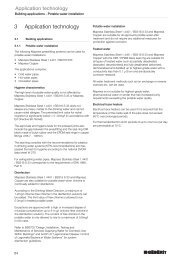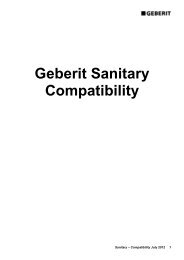Geberit View 2012
Geberit View 2012
Geberit View 2012
Create successful ePaper yourself
Turn your PDF publications into a flip-book with our unique Google optimized e-Paper software.
Spectrum Technology<br />
↑ Generous glass surfaces give rhythm to the building structures of the Ecole Nonnewisen.<br />
For some time, EschsurAlzette, the secondlargest<br />
town in Luxembourg, has been<br />
redefining its economic and urban future.<br />
As part of this development, a school complex<br />
has been created for 270 preschool<br />
and elementary school children in the district<br />
of Nonnewisen, which is home to<br />
around 1,500 inhabitants. The new school<br />
facility was designed by the architecture<br />
firm Auer+Weber in Stuttgart in collaboration<br />
with the Atelier d’Architecture BENG in<br />
EschsurAlzette. The schoolyard, which is<br />
open to the public outside school hours,<br />
forms the “green hub” between the school<br />
and the sports facilities and opens onto the<br />
Parc de Centenaire opposite it on the south<br />
side. Despite the building’s relatively large<br />
size, the architects managed to create a<br />
scale and proportion that is appropriate for<br />
the preschool and elementary school children,<br />
thus making it easier for them to find<br />
their way around. The individual buildings<br />
are combined to create an artistic ensemble<br />
by means of the structure of the generously<br />
dimensioned glass elements and<br />
closed facade sections made of concrete<br />
blocks.<br />
Certified fire protection system<br />
from <strong>Geberit</strong><br />
Fire protection is naturally also required by<br />
today’s standards for school buildings. In<br />
addition to standard solutions, <strong>Geberit</strong><br />
also supplies solutions customized to individual<br />
situations for special architectural<br />
challenges. This is also true of the school in<br />
EschsurAlzette, in which <strong>Geberit</strong> products<br />
that ensure allround fire protection<br />
were used. The best way to ensure comprehensive<br />
fire protection is with a system<br />
solution, i.e. by using individual components<br />
coordinated to optimize fire protection<br />
characteristics. All components relevant<br />
to fire protection are included in the<br />
system. The installed Mapress drinking<br />
water pipes were protected by special pipe<br />
jacketing. The Silentdb20 drainage pipes<br />
are protected by fire protection sleeves<br />
that prevent fire from spreading to other<br />
rooms. The cavities in the walls containing<br />
the GIS installation system are filled with<br />
mineral wool, lending them insulating and<br />
fireprotecting properties. Even the Pluvia<br />
roof outlet was equipped with a fire protection<br />
sleeve. ←<br />
Situational<br />
solutions<br />
Fire protection is<br />
the top priority<br />
Ecole Nonnewisen, Esch-sur-Alzette (LU)<br />
Building owner: Ville d’Esch-sur-Alzette (LU)<br />
Architect: Auer+Weber+Assoziierte GmbH,<br />
Stuttgart (DE); Atelier d’Architecture BENG,<br />
Esch-sur-Alzette (LU)<br />
Completed: 4/<strong>2012</strong><br />
Sanitary engineers: Goblet Lavandier &<br />
Associés, Luxembourg (LU)<br />
Plumber: MBW Technique du Bâtiment SA,<br />
Luxembourg (LU)<br />
<strong>Geberit</strong> know-how<br />
Pluvia roof drainage system<br />
Silent-db20 drainage system<br />
Mapress stainless steel piping system<br />
GIS installation system<br />
Duofix installation system<br />
Comprehensive fire protection<br />
The fire behavior of <strong>Geberit</strong> products and<br />
systems is tested in collaboration with external<br />
testing institutes. <strong>Geberit</strong>’s Building Physics<br />
division holds seminars on the principles of fire<br />
protection and demonstrates for its own development<br />
engineers and designers the effectiveness<br />
of the fire protection measures. It tests<br />
and evaluates prototypes and mass-produced<br />
products. In addition, it carries out fire tests<br />
appropriate to building material classes and fire<br />
resistance, taking into consideration the<br />
different fire protection requirements in various<br />
countries. All <strong>Geberit</strong> products have been subjected<br />
to fire testing.<br />
Spectrum Technology<br />
↑ National object of prestige: The new stadium in Warsaw is in the national colors of red and white.<br />
A red-and-white giant<br />
<strong>Geberit</strong> drinking water competence<br />
in the Warsaw national stadium<br />
The new national stadium is a striking feature<br />
on the urban landscape of Warsaw that<br />
can be seen for miles. The venue of the<br />
opening game of the <strong>2012</strong> UEFA European<br />
Football Championship is around two kilometers<br />
away from the banks of the Vistula<br />
River in a park with large open spaces,<br />
sports facilities and trees. The stadium is at<br />
the center of a new, largescale “sport<br />
park” that was created to revitalize the entire<br />
area. The stateoftheart, multifunctional<br />
arena was built on the foundations of<br />
the Dziesięciolecia Stadium that was built in<br />
1955 from the rubble left after World War II.<br />
An international architecture competition<br />
was advertised for the new construction in<br />
2007 that was won by the global architecture<br />
group GMP (von Gerkan, Marg and<br />
Partners) in collaboration with J.S.K. Architekci<br />
and Schlaich Bergermann und Partner.<br />
The complex incorporating the Polish<br />
national colors of red and white with a facade<br />
of meshed metal baffle seats 55,000<br />
fans. The interwoven facade elements<br />
also create a fascinating play of light and<br />
shade when the incoming light is weak.<br />
Apart from its color scheme, another striking<br />
detail of the building is its roof. The unusual<br />
roof cable construction is supported<br />
on a freefloating “needle.” The “needle,”<br />
with its lower tip suspended 30 meters<br />
above the playing field, is kept in the air by<br />
a clever, closable tent roof construction.<br />
Geared to sustainability<br />
Sustainability was a main priority in building<br />
the stadium. One example is the water<br />
supply: The toilets and urinals are flushed<br />
with rainwater. As a company that is strictly<br />
committed to sustainability, <strong>Geberit</strong> was<br />
able to win the contract for the concealed<br />
systems for the 2,100 toilets and urinals.<br />
The durability and safety of the products<br />
were equally convincing arguments, as was<br />
the special vandalism protection provided<br />
by the screwed actuator plates made of<br />
stainless steel.<br />
<strong>Geberit</strong> sanitary flushings were used for<br />
the flushing systems. They guarantee the<br />
safety of the fresh water by regularly flushing<br />
the water in the pipes, thereby preventing<br />
possible microbial contamination of the<br />
drinking water. Water must be able to flow<br />
and circulate so that it is constantly replaced.<br />
For this reason, <strong>Geberit</strong> developped<br />
the sanitary flushing that ensures<br />
that stagnation times are minimized and<br />
freshness is maintained by regular, auto<br />
National stadium, Warsaw (PL)<br />
Building owner: Narodowe Centrum Sportu Sp. Z.o.o. (PL)<br />
Architects: von Gerkan, Marg and Partners (gmp),<br />
Hamburg (DE); in collaboration with J.S.K. Architekci<br />
Sp. Z.o.o., Warsaw (PL); Schlaich Bergermann und<br />
Partner, Stuttgart (DE)<br />
Opened: 1/<strong>2012</strong><br />
Plumber: Imtech, Hamburg (DE)<br />
<strong>Geberit</strong> know-how<br />
Duofix installation system<br />
Electronic urinal flush control and lavatory tap<br />
Sanitary flushing<br />
matic replacement of the drinking water.<br />
The <strong>Geberit</strong> sanitary flushings can be easily<br />
programmed and adapted to the different<br />
uses of the sanitary installations. They can<br />
be integrated into the building service management<br />
system and therefore controlled<br />
and monitored from a central point. ←<br />
For perfect drinking water<br />
<strong>Geberit</strong> regards keeping drinking water in<br />
hygienically perfect condition by providing<br />
suitable, certified products as an ongoing<br />
challenge and task. To achieve this goal, the<br />
company uses only high-quality materials.<br />
Another risk for drinking water contamination<br />
is the transport and storage of pipes and<br />
fittings without protective caps, which can<br />
result in contamination of the insides of the<br />
pipes. During the production of pipes and<br />
fittings, <strong>Geberit</strong> ensures that they are in<br />
hygienically perfect condition when they leave<br />
the plant. The <strong>Geberit</strong> Mapress and Mepla<br />
piping systems, which are suitable for drinking<br />
water pipes, are equipped with protection<br />
plugs to prevent the ingress of dirt and foreign<br />
bodies. The plant also places protective caps,<br />
which can be reused for closing off installed<br />
system components, on fittings. When the<br />
drinking water installation is filled with water<br />
for the first time, <strong>Geberit</strong> hygiene filters retain<br />
any microorganisms. This ensures that only microbiologically<br />
perfect drinking water is used<br />
to fill the system for the first time.<br />
38 <strong>View</strong> – Reference magazine <strong>2012</strong> 39





